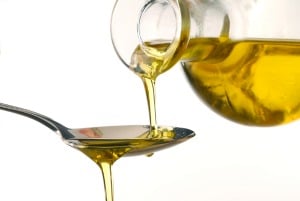Safflower oil has gained popularity in recent years in the natural food industry. Though it’s not quite as prevalent as it’s cousin sunflower oil or the food industry main-stay of canola oil, brands are starting to use it more and more.
Without much experience with safflower, many people question if it’s an oil that they should be using in food production or eating in their own kitchens. Is it good or is it bad?
It’s hard to know much about safflower instinctively: the name doesn’t mean much to us — after all, what is a safflower anyways? To make things a little bit more confusing, this oil is often used interchangeably with sunflower oil as well.
Today, I’ll start at the beginning to give you the low down on safflower oil. Why people do or don’t like it, and whether you should be eating it.
What Is Safflower Oil Made From?
Safflower oil is made from the safflower. It is a knee-high, stalky spiky plant that has a brightly colored sharp bulb at the top of it. Inside this bulb (or flower) are the safflower seeds that are used to make the oil.

The Characteristics of Safflower Oil
Safflower oil is a mild, unobtrusive oil that has a high heat tolerance and very little flavor. It’s often used for frying and sautéing because it doesn’t impart it’s own taste or aroma into the dishes, but is more often used for functionality.
In general, this oil has:
- Light yellow, almost clear color
- Very little flavor profile
- Mild smell and aroma
- High smoke point and good heat tolerance
- High oleic versions are stable offering a long fry and shelf life
These features listed above are all benefits. It’s also typically found an expeller pressed, healthy-fat-filled oil. So there’s lots of reasons that safflower oil is a good fit for an ingredient and as a cooking oil.
So why would or wouldn’t someone want to use safflower oil? Any cons related to safflower are usually connected to misunderstandings about seed oils in general — what is true for some seed oils, people will mistakenly apply to all seed oils without a full understanding.
But safflower can be different in many ways. Read on, and I’ll explain.
It’s Doesn’t Contain High Trans Fats
Trans fats are something that a lot of people discuss when they talk about vegetable oils in general. Any oil that contains trans fats are typically seed oils (soy, canola, etc) that are modified using a process called “partial hydrogenation”. This is a chemical process that makes liquid oil turn to solid at room temperature. This process also makes the oil molecules unstable and creates trans fats.
There’s a few truths and a few myths related to safflower in here. It IS true that vegetable oils like canola and soybean oil used to be partially hydrogenated to be solid at room temperature. This process has been used for decades as a replacement for butter (aka, this is what margarine is).
However, this argument actually has nothing to do with safflower oil. Even though it is a seed oil it isn’t (and never was) a partially hydrogenated seed oil. It is a liquid, and it doesn’t contain the trans fats that are created through the partial hydrogenation process.
While we’re discussing though, here’s bit more background on the updated status of partially hydrogenated oils (PHOs)…
In recent years these PHOs have been looked at more closely by scientists and legislation alike. In fact, as of July 2018, PHOs are no longer considered “GRAS” by the FDA; GRAS is a term that means Generally Recognized As Safe. That’s right, partially hydrogenated oils are no longer considered safe to eat by our government starting in July of 2018. Companies have been working for months now to reformulate products so that they no longer contain these partially hydrogenated oils.
Let’s be clear on this front — stay away from PHOs at all costs, please! The partial hydrogenation process leaves unstable molecules which is what creates trans fats. A fully hydrogenated oil is different and is much more stable. These oils don’t contain trans fats, and you’re going to see them more and more in the years to come.
All of that said, safflower oil was never one of those oils that was partially hydrogenated to be solid at room temperature. Of course, there’s always exceptions, but in general it has always been a liquid oil. So it doesn’t contain trans fats in the same way that a PHO soybean oil or PHO canola oil would. But even those are going by the wayside now!
Monounsaturated & Polyunsaturated Fat Levels
Other arguments against safflower oil have to do with the higher level of polyunsaturated fat vs. monounsaturated fat. If you want to learn more about these type of fats that make up different oils, I’d recommend swapping over to read these two articles first:
Comparing Types Of Fat: Monounsaturated Polyunsaturated Saturated & Trans
Monounsaturated Vs. Polyunsaturated Vs. Saturated Fat: What Are They?
As humans, we need both types of fat: mono and poly. Polyunsaturated fat used to be hailed in the 70s as the healthy fat. That said, science has developed quite a bit since then and they are learning that monounsaturated fats are actually the “healthy-for-you” fats. We do need some level of polyunsaturated fats, but it’s not very high. We need a much higher level of monounsaturated fats, as these are the type of fats that protect rather than oxidize once they’re in your system.
Safflower oil is usually found as a “high oleic” oil. This means that any arguments against an oil high in polyunsaturated fats doesn’t apply — high oleic safflower has very high levels of monounsaturated fats and very low levels of polyunsaturated fats.
High-Oleic Safflower Oil
High-oleic safflower oil consists primarily of monounsaturated oleic acids, at around 70-80 percent of the total fat make-up. Saturated fats and polyunsaturated linoleic acid make up the balance.
 Bulk high-oleic safflower oil is important in the manufacturing of natural food products, because it remains stable without hydrogenation and will not go rancid in storage.
Bulk high-oleic safflower oil is important in the manufacturing of natural food products, because it remains stable without hydrogenation and will not go rancid in storage.
High oleic safflower oil actually can have higher monounsaturated fat levels than olive oil — and olive oil is known as a good oil because it contains this healthy fat! Safflower has even more!
Solvent Expelled or Expeller Pressed
All safflower oils can either be solvent expelled or expeller pressed. Solvent expelled oils use a chemical like hexane to pull the oil out of the seed. Expeller pressed oils physically squeeze the oil out of the seed without using chemicals to extract it.
While solvent expelled safflower oil can be found on the market, the most commonly found type (especially in the natural food industry) is the expeller pressed version. That said, it can still be solvent expelled so it’s important to keep your eye out for this feature on the retail bottle or bulk manufacturing spec sheet.
Safflower Oil Is Refined
Safflower oil typically goes through a natural refining process. Many natural oils undergo this process; the exact refining process is different for each type of oil, though there are some components that look very similar.
For the most part, it is usually a high heat process, which uses heat or steam. It also typically use an earthen bleaching clay to pull any pigment from of the oil. Lastly, the process will often involve filtering, or sometimes double filtering the final product.
The end result is a light colored, neutral flavored, almost-clear oil. This refining process is also used with many different oils: for example canola, soybean, coconut and grapeseed oil along with pure olive oil, extra light olive oil and many more.
The only oils that are not refined in this way are Extra Virgin Olive Oil, Organic Virgin Coconut Oil and those oils that state “unrefined” clearly on the label.
In Conclusion: Is Safflower Oil Good or Bad?
High oleic expeller pressed safflower oil has high monounsaturated fat levels in comparison to many of the other oil options. In fact, it often has more monounsaturated fat than olive oil does.
It’s usually expeller pressed — aka, it doesn’t use a chemical solvent to extract the oil, though it is refined. It also doesn’t trans fats. At the end of the day, this oil is rather healthy for you in comparison to many other options.
Now, if you asked me if I would rather eat Expeller Pressed High Oleic Safflower Oil vs. Extra Virgin Olive Oil in my home kitchen, I would still say Extra Virgin Olive Oil — personal preference, but it’s a close call. What would I want my chips to be fried in? Expeller Pressed High Oleic Safflower Oil, hands down.
Manufacturing Advice Related To Safflower Oil
Many manufacturers today in the natural food industry use high oleic expeller pressed sunflower oil and high oleic expeller pressed safflower oil interchangeably. These two oils have very similar taste and functionality, and of course, they are both high oleic and expeller pressed.
Many chip companies today use an “and/or” statement on their ingredient label, which allows them a bit more flexibility and risk management in their supply chain to use both of these options interchangeably.
If you want to learn more about why this is an ideal choice to make for your company, we recommend reading more: Why It's Ideal To List Multiple Interchangeable Bulk Oil Ingredients
Topics: Sunflower/Safflower Oil












